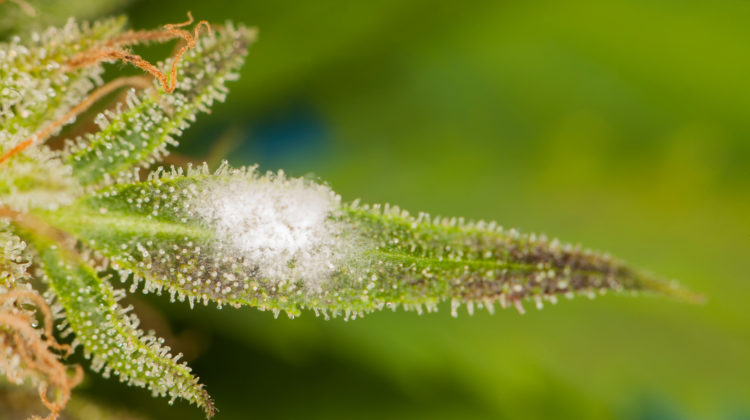
White mold on the cannabis plant. Photo credit: ElRoi.
Light, temperature, humidity — all of these take part in the development of mold on cannabis. Even lab-tested products which are sold in dispensaries can develop mold. These organisms are everywhere, and they are quite tricky to identify. The ingestion of moldy cannabis could be harmful. Therefore, it is essential for users to know how to recognize mold on cannabis products.
First Things First: What is Mold?
Mold is a group of microorganisms that grow in humid and damp surroundings with poor air ventilation, according to the Center for Disease Control and Prevention (CDC). It reproduces by generating small, light, fungal spores. It can be black, white, orange, green or purple.
Outside, mold performs a significant role in nature by breaking down dead leaves, trees and plants. People inhale or eat small quantities of mold every day, most of it is not harmful to a healthy immune system at all, according to WebMD.
Mold on Cannabis
Once mold spores developed on cannabis, they are exceedingly hard to get rid of. They can withstand combustion when heated with a lighter, as well as the decarboxylation process in an oven. Some mold that grows on cannabis can generate mycotoxins, harmful compounds which cause severe disease in humans, according to the state-certified testing lab, PureLabs.
“Mold is not very common in cannabis products, but they can be introduced through growing and storage conditions that allow for mold proliferation. Cured flower products are more at risk for mold contamination since they are agricultural products that are stored in dark conditions under certain humidity requirements in which mold prefers,” says Ini Afia, chief science officer at CannaSafe, a cannabis testing lab.
The two most common types of mold found on cannabis plants are grey mold, also known as botrytis, and white powdery mildew.
Grey Mold
Grey mold is the most prevalent form of fungus that infects cannabis plants. Growers can encounter it on plants grown indoors, outdoors, or in a greenhouse. It generally affects plants at the end of their flowering cycle; although it can also form throughout the drying process, according to Fast Buds, a seed bank specializing in auto-flowering cannabis.
The amount of humidity is the most important element in the development of botrytis. The higher the humidity level, the more possibility that fungus will wreak havoc on the cannabis plants, says Dinafem, a cannabis seed bank.
Furthermore, grey mold usually develops in temperatures ranging from 63°F to 77°F. It can also develop if the temperature difference between day and night is dramatic.
White Powdery Mildew
White powdery mildew is a fast-reproducing fungus which is usually busy doing only two things: eating one’s plants and self-reproducing. Fortunately, this type of mold is simple to identify since it generates white fungal growth patches, which are noticeable on the green cannabis plant.
If white powdery mildew is found early on a growing plant, it may be eradicated with proper treatment, according to the online cannabis cultivation resource, Grow Weed Easy.
Firstly, gently wipe the mildew off the affected leaves with wet paper towels. Secondly, enhance the airflow and ventilation so the plants lightly rustle their leaves. This will make it hard for mildew to settle down. And thirdly, kill the rest of the spores and prevent future growth by treating the plants with the treatment of choice. Grow Weed Easy recommends Lost Coast Plant Therapy (1ounce/2 tablespoons per gallon of water) or GrowSafe (2 ounces/4 tablespoons per gallon of water). Just mix up the treatment in a sprayer and mist the plants at the end of the day.
Growers or consumers should not use any infected buds because they probably contain more spores than human eyes can detect.
Is it Safe to Ingest Moldy Cannabis?
“Ingesting mold can be very dangerous. It can cause respiratory issues and/or allergic reactions; it can exacerbate those conditions for those with underlying conditions,” says Ini Afia of CannaSafe. “For an otherwise healthy individual, there is a low chance that you will get sick or display symptoms after ingesting small amounts of mold.”
According to Herb, the possible reactions can include chest pain, cough, itchy eyes and fever. If one inhaled or consumed moldy cannabis only a few times and not in a big amount, the symptoms should continue for a short period. Long-term exposure, however, can lead to severe pulmonary conditions, according to Bloom Medicinals, a medical cannabis dispensary.
Not only will mold bring negative effects on one’s health, but it will also destroy cannabinoids and terpenes. In this case, the only right thing to do is to throw it away.
How to Protect Cannabis From Mold?
The greatest way for growers to avoid mold on cannabis is not to give them a proper starting point. The mold develops only in extremely damp conditions, so the first defense against it should be to keep the storage place at a relative humidity of 59% to 63%, by monitoring the hygrometer, which measures water vapor in the air.
“Consumers can avoid mold exposure by ensuring they are buying from licensed dispensaries and asking for the certificates of analyses from accredited state labs. California, for instance, requires PCR which picks up DNA that may be present from mold but not visible,” says Ini.
Also, cannabis shouldn’t be stored in a freezer or refrigerator. Such temperatures are too low and humidity exposure might cause mold. The optimal storage temperature for cannabis is just about 77°F, according to Bloom Medicinals.
Glass jars with airtight seals are also great tools to help keep the cannabis mold-free. Glass containers restrict oxygen exposure and moisture, therefore preventing mold and keeping the herbs fresh longer.
Direct light and dampness are a catastrophic mix for fresh cannabis. The sun may heat it up and keep in moisture. If the container is also not sealed well, a damp atmosphere may cause moisture to build up. Keep the container in a dry, dark cabinet or closet.
Moldy cannabis will generally have a bad taste or an off-odor like a wet basement. Consequently, it is always a good idea to check the product before consuming it.
Individuals with chronic lung conditions should be especially careful. It is always best to throw out anything that doesn’t look quite right.



Nice article!
Mold, such a treacherous thing!
2 plants this year, both destroyed by mold, gonna have to do some investments for next year. Disastrous !!!!
Both the main types of mold listed in this article are scientifically proven as almost entirely harmless to humans with the exception of some discomfort (Nothing more than that) from Botrytis c. if you’re predisposed to ask allergy to it.
So does this mean I can or can’t dry of my joint I accidentally left outside?…
Hi. I had two plants that developed grey mould.
I have turned them into oil with alcohol and evaporated to extract the oil.
Will this have killed the mould and be OK to smoke.
Thanks.
Hi. I had two plants that developed grey mould.
I have turned them into oil with alcohol and evaporated to extract the oil.
Will this have killed the mould and be OK to smoke.
Thanks.
Found a box of mouldy weed on the roadside. Bottom stuff was proper mouldy but branches on top were bone dry but very dark, even blackish. My experience is that .mould breaks down the cell walls and makes buds mushy at first and then crumbly when it dries. This top lot is not at all crumbly, but very firm.. I’ve made an edible oil from it. Is it safe to consume. I have cancer and use it medicinely. The dark colour worries me. I’ve never seen anything similar but maybe it’s a different strain. Please advise if you know anything. Thanks! Lee
I get the purple/blackish mould on lower buds and cut them off as it seems to travel up the plant. Lost 3 whole plants this year but no issues with powdery mildew.